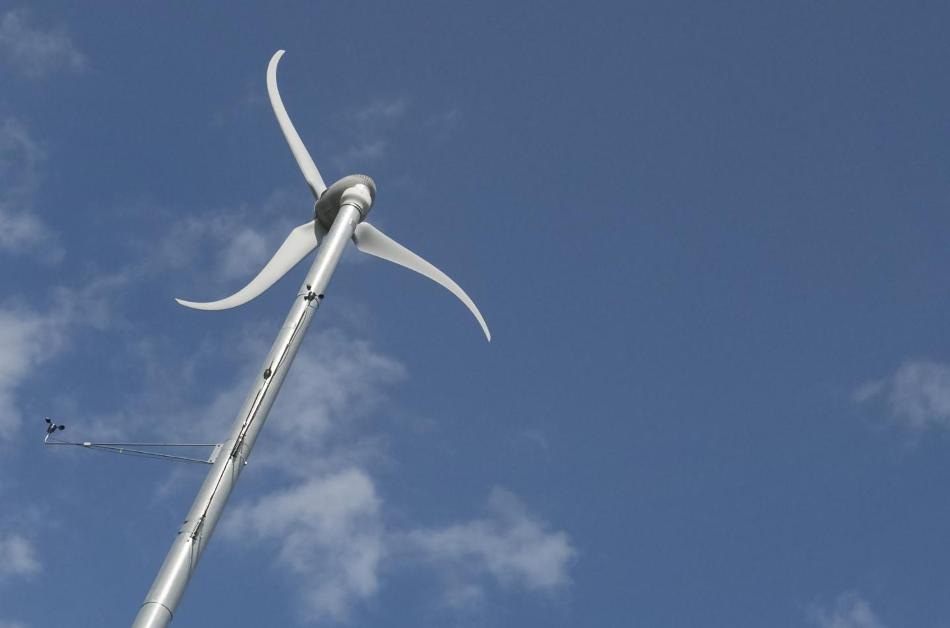Nov 12 2018
The growing demands for energy have prompted scientists at Penn State Behrend and the University of Tabriz, Iran, to complete a new algorithm, or method, to design highly efficient wind farms that would not only help in generating more revenue for builders but would also aid in producing renewable energy for their customers.
 This is a wind turbine at the Penn State Sustainability Institute, University Park. (Image credit: Patrick Mansell/Penn State)
This is a wind turbine at the Penn State Sustainability Institute, University Park. (Image credit: Patrick Mansell/Penn State)
Wind energy is on the rise, and not just in the US. The efficiency of solar panels is less than 25 percent, and is still a subject of current research. Wind turbines, on the other hand, are much more efficient and convert over 45 percent of the wind energy to electricity.
Mohammad Rasouli, Assistant Professor of Electrical Engineering, Penn State Behrend
Although wind turbines are known to be efficient, improperly designed wind farm layouts can reduce this efficiency. Builders do not invariably install turbines in places that have the highest wind speeds, where they will produce the maximum power, stated Rasouli. Turbine spacing is equally significant—since turbines create drag that reduces wind speed, the first turbines to catch the wind will be able to produce more amounts of power when compared to those that come after.
In order to develop more efficient wind farms, designers should consider the following factors—turbine spacing, wind speed, geography, land size, amount of vegetation, number of turbines, building costs, meteorological conditions, and other considerations, say the researchers.
Even with the help of mathematical models, it is difficult to balance all these factors to identify an optimum layout.
“This is a multi-objective approach,” stated Rasouli. “We have a function and we want to optimize it while taking into account various constraints.”
The team focused on a method known as “biogeographical-based optimization” or BBO. Inspired by nature and developed in 2008, the BBO approach is based on the way animals naturally distribute themselves to make the optimum use of their environment depending on their requirements. When the researchers developed a mathematical model based on animal behavior, it allowed them to measure the optimal distribution of objects in other situations, for example, turbines on a wind farm.
Analytical methods require a lot of computation. This BBO method minimizes computation and gives better results, finding the optimum solution at less computational cost.
Mohammad Rasouli, Assistant Professor of Electrical Engineering, Penn State Behrend
In 2017 and 2018, other researchers employed basic versions of the BBO method to determine the layouts of more efficient wind farms, but these versions did not consider all the factors that impact the optimum layout.
The research team from the University of Tabriz and Penn State completed the BBO approach by considering extra variables, such as real market data, the surface roughness—which impacts the amount of power present in the wind—and the amount of wind received by each turbine.
To further improve the BBO approach, the researchers incorporated a more realistic model for determining wakes—areas with slower wing speeds produced after the wind moves past a turbine, akin to the wake behind a boat—and testing the model’s response to other factors like financial incentives, interest rates, and variations in energy production costs. The team has reported the study results in the Journal of Cleaner Production, which will be published in this month.
This is a more realistic optimization approach compared to some of the simplifying methods that are out there. This would be better to customers, to manufacturers, and to grid-style, larger-size wind farms.
Mohammad Rasouli, Assistant Professor of Electrical Engineering, Penn State Behrend
By integrating additional data, for example, manufacturer information and updated meteorological records, the team will be able to apply the BBO method to improve the layouts of wind farms in many different sites, thereby aiding wind farm designers worldwide to make optimum use of their land and produce more power to meet the consumers’ future energy needs.
“There is an end time for fossil fuels,” stated Rasouli. “With this and upcoming methods or better optimization approaches, we can make better use of wind energy.”
Other team members who also worked on the project were Soheil Pouraltafi-kheljan and Amirreza Azimi, graduate students, and Behnam Mohammadi-ivatloo, associate professor and faculty of electrical and computer engineering, all from the University of Tabriz.